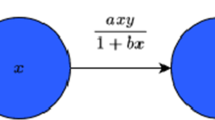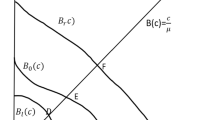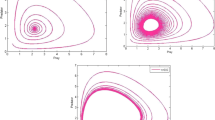Abstract
To explore the efficacy of integrated pest management, we modify the predator–prey (pest–natural enemy) model by incorporating Holling III functional response and transform it into a non-smooth Filippov control system. Unlike conventional Filippov systems, the model takes into consideration time delay and spatial heterogeneity. Consequently, we establish and examine a delayed reaction–diffusion Filippov prey–predator model. Firstly, the dynamics of the two subsystems are analyzed, which includes the existence and stability of the equilibrium points, along with determining the adequate conditions for local Hopf bifurcation. Subsequently, we implement a detailed investigation of the sliding mode dynamics and stability of the pseudoequilibrium. Theoretical and numerical simulations indicate that on the one hand, the threshold level should be prescribed adequately to reduce the pest population equal to or below the threshold level. On the other hand, reading from the boundary node and boundary focus bifurcations, slightly varying the economic threshold may save a failure control strategy by dragging the number of the pests from a regular equilibrium above the threshold to a boundary equilibrium or a pseudoequilibrium equal to the threshold. Furthermore, the sequent appearance of global sliding bifurcations including touching, sliding switching and crossing bifurcations expound that the incorporation of time delay not only complicates the dynamics of the system, but also brings more challenge for pest control.










Similar content being viewed by others
Data availability
Data sharing is not applicable to this article as no datasets were generated or analysed during the current study. Others are not applicable.
References
Volterra, V.: Variations and fluctuations of the number of individuals in animal species living together. ICES J. Mar. Sci. 3, 3–51 (1928)
Lotka, A.: Elements of Physical Biology. William & Wilkins Companies, Philadelphia (1925)
Leslie, P.: Some further notes on the use of matrices in population mathematics. Biometrika 35, 213–245 (1948)
Jiao, X., Yang, Y.: Rich dynamics of a Filippov plant disease model with time delay. Commun. Nonlinear Sci. 114, 106642 (2022)
Jiao, X., Li, X., Yang, Y.: Dynamics and bifurcations of a Filippov Leslie–Gower predator–prey model with group defense and time delay. Chaos Soliton Fractals 162, 112436 (2022)
Wang, H., Yang, Y.: Dynamics analysis of a non-smooth Filippov pest–natural enemy system with time delay. Nonlinear Dyn. 111, 9681–9698 (2023)
Moknia, K., Elaydi, S., Ch-Chaoui, M., Eladdadi, A.: Discrete evolutionary population models: a new approach. J. Biol. Dyn. 14(1), 454–478 (2020)
Liu, Y., Yang, Y.: Dynamics and bifurcation analysis of a delay non-smooth Filippov Leslie–Gower prey–predator model. Nonlinear Dyn. 111, 18541–18557 (2023)
Wollkind, D.J., Logan, J.A.: Temperature-dependent predator–prey mite ecosystem on apple tree foliage. J. Math. Biol. 6, 265–83 (1978)
Hu, D., Li, Y., Liu, M., Bai, Y.: Stability and Hopf bifurcation for a delayed predator–prey model with stage structure for prey and Ivlev-type functional response. Nonlinear Dyn. 99(4), 3323–50 (2020)
Wang, W., Cai, Y., Zhu, Y., Guo, Z.: Allee-effect-induced instability in a reaction-diffusion predator-prey model. Abstr. Appl. Anal. 2013, 487810 (2013)
Huang, Y., Li, F., Shi, J.: Stability of synchronized steady state solution of diffusive Lotka–Volterra predator–prey model. Appl. Math. Lett. 105, 106331 (2020)
Ma, X., Shen, S., Zhu, L.: Complex dynamic analysis of a reaction–diffusion network information propagation model with non-smooth control. Inf. Sci. 622, 1141–1161 (2023)
Zhu, M., Xu, H.: Dynamics of a delayed reaction–diffusion predator–prey model with the effect of the toxins. Math. Biosci. Eng. 20(4), 6894–6911 (2023)
Liu, Z., Zhang, L., Bi, P.: On the dynamics of one-prey–n-predator impulsive reaction–diffusion predator–prey system with ratio-dependent functional response. J. Biol. Dyn. 12(1), 551–576 (2018)
Zhu, H., Zhang, X., Wang, G.: Effect of toxicant on the dynamics of a delayed diffusive predator–prey model. J. Appl. Math. Comput. 69(1), 355–379 (2023)
Ducrot, A., Guo, J., Shimojo, M.: Behaviors of solutions for a singular prey–predator model and its shadow system. J. Dyn. Differ. Equ. 30(3), 1063–1079 (2018)
Kuwamura, M.: Turing instabilities in prey–predator systems with dormancy of predators. J. Math. Biol. 71(1), 125–149 (2015)
Bie, Q., Peng, R.: qualitative analysis on a reaction–diffusion prey–predator model and the corresponding steady-states. Chin. Ann. Math. B 30(2), 207–220 (2009)
Liu, J., Zhang, X.: Stability and Hopf bifurcation of a delayed reaction–diffusion predator–prey model with anti-predator behaviour. Nonlinear Anal. Model. 24(3), 387–406 (2019)
Zhu, L.H., Zhou, M.T., Liu, Y., Zhang, Z.D.: Nonlinear dynamic analysis and optimum control of reaction–diffusion rumor propagation models in both homogeneous and heterogeneous networks. J. Math. Anal. Appl. 502, 125260 (2021)
Wang, J.L., Jiang, H.J., Ma, T.L., Hu, C.: Global dynamics of the multi-lingual SIR rumor spreading model with cross-transmitted mechanism. Chaos Solitons Fractals 126, 148–57 (2019)
Liu, L., **ang, C., Tang, G.: Dynamics analysis of periodically forced Filippov Holling II prey–predator model with integrated pest control. IEEE Access 7, 113889–113900 (2019)
Tang, G., Qin, W., Tang, S.: Complex dynamics and switching transients in periodically forced Filippov prey–predator system. Chaos Solitons Fractals 61, 13–23 (2014)
Zhu, L., Zheng, W., Shen, S.: Dynamical analysis of a SI epidemic-like propagation model with non-smooth control. Chaos Solitons Fractals 169, 113273 (2023)
Kuwamura, M.: Turing instabilities in prey–predator systems with dormancy of predators. J. Math. Biol. 71, 125–149 (2015)
Pei, Y., Li, C., Fan, S.: A mathematical model of a three species prey–predator system with impulsive control and Holling functional response. Appl. Math. Comput. 219(23), 10945–10955 (2013)
Qin, W., Tan, X., Shi, X., Chen, J., Liu, X.: Dynamics and bifurcation analysis of a Filippov predator–prey ecosystem in a seasonally fluctuating environment. Int. J. Bifurc. Chaos 29(2), 1950020 (2019)
Hamdallah, S., Arafa, A., Tang, S., Xu, Y.: Complex dynamics of a Filippov three-species food chain model. Int. J. Bifurc. Chaos 31(05), 2150074 (2021)
Hamdallah, S., Tang, S.: Stability and bifurcation analysis of Filippov food chain system with food chain control strategy. Discrete Contin. Dyn. B 25(5), 1631–1647 (2020)
Zhang, X., Tang, S.: Existence of multiple sliding segments and bifurcation analysis of Filippov prey–predator model. Appl. Math. Comput. 239, 265–284 (2014)
Qin, W., Tan, X., Shi, X., Tosoto, M., Liu, X.: Sliding dynamics and bifurcations in the extended nonsmooth Filippov ecosystem. Int. J. Bifurc. Chaos 31(8), 2150119 (2021)
Qin, W., Tan, X., Tosato, M., Liu, X.: Threshold control strategy for a non-smooth Filippov ecosystem with group defense. Appl. Math. Comput. 362, 124532 (2019)
Arafa, A.A., Hamdallah, S., Tang, S., Xu, Y., Mahmoud, G.M.: Dynamics analysis of a Filippov pest control model with time delay. Commun. Nonlinear Sci. Numer. Simul. 101, 105865 (2021)
Mahmoud, G.M., Arafa, A.A., Mahmoud, E.E.: Bifurcations and chaos of time delay Lorenz system with dimension \(2n+1\). Eur. Phys. J. Plus 132(11), 461 (2017)
Onana, M., Mewoli, B., Tewa, J.: Hopf bifurcation analysis in a delayed Leslie–Gower predator–prey model incorporating additional food for predators, refuge and threshold harvesting of preys. Nonlinear Dyn. 100(3), 3007–3028 (2020)
Yuan, R., Jiang, W., Wang, Y.: Saddle–node–Hopf bifurcation in a modified Leslie–Gower predator–prey model with time-delay and prey harvesting. J. Math. Anal. Appl. 422(2), 1072–1090 (2015)
Zhang, X., Zhao, H.: Dynamics analysis of a delayed reaction–diffusion predator–prey system with non-continuous threshold harvesting. Math. Biosci. 289, 130–141 (2017)
Zhang, X., Zhao, H., Yuan, Y.: Impact of discontinuous harvesting on a diffusive predator–prey model with fear and Allee effect. Z. Angew. Math. Phys. 73(4), 168 (2022)
Zhang, X., Zhao, H.: Dynamics and pattern formation of a diffusive predator–prey model in the presence of toxicity. Nonlinear Dyn. 95(3), 2163–2179 (2019)
Dubey, B., Kumar, A., Maiti, A.: Global stability and Hopf bifurcation of prey–predator system with two discrete delays including habitat complexity and prey refuge. Commun. Nonlinear Sci. Numer. Simul. 67, 528–554 (2019)
Wei, J., Zhang, C.: Stability analysis in a first-order complex differential equations with delay. Nonlinear Anal. Theor. 59(5), 657–671 (2004)
Funding
This work is supported by Shandong Provincial Natural Science Foundation of China (No. ZR2023YQ002).
Author information
Authors and Affiliations
Corresponding author
Ethics declarations
Conflict of interest
We declare that we have no conflict of interest.
Additional information
Publisher's Note
Springer Nature remains neutral with regard to jurisdictional claims in published maps and institutional affiliations.
Rights and permissions
Springer Nature or its licensor (e.g. a society or other partner) holds exclusive rights to this article under a publishing agreement with the author(s) or other rightsholder(s); author self-archiving of the accepted manuscript version of this article is solely governed by the terms of such publishing agreement and applicable law.
About this article
Cite this article
Liu, Y., Yang, Y. Impact of non-smooth threshold control on a reaction–diffusion predator–prey model with time delay. Nonlinear Dyn 112, 14637–14656 (2024). https://doi.org/10.1007/s11071-024-09796-1
Received:
Accepted:
Published:
Issue Date:
DOI: https://doi.org/10.1007/s11071-024-09796-1




